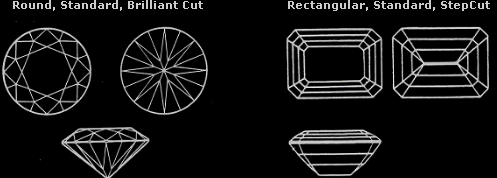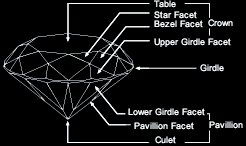|
Diamond Education
Color
| Clarity
| Cut | Carat
Weight | Shape
Diamond Cut
When the term "cut" is first introduced, most
people think of the diamond's shape. However, "cut" refers to the
diamond's proportions and finish. Cutting is the contribution made by man
transforming the rough diamond crystal into a faceted, polished gem. The
cutter's primary goals are to produce the largest size diamond and achieve the
greatest optical beauty.
When a diamond is cut to proper proportions and is
finished well, light refracts into the diamond, is reflected from one facet to
another and then returns through the top of the gem resulting in a display of
brilliance (white light), dispersion (rainbow-colored light) and scintillation
(sparkling when the diamond moves), and luster (bright reflections from the
surface). Proper cutting is the key to a diamond's beauty and value.
Most diamond shapes are cut with 58 facets, or separate
flat surfaces, according to mathematical formulas. Using symmetry, the cutter
aligns these facets at precise angles in relation to each other to maximize the
reflection and refraction of light.
The proportions are calculated in angles &
percentages that show how well the diamond refracts and reflects light. They
will help you understand the range of well-cut diamonds offered by Mansfield
Designs,.
When purchasing a diamond, you also may want to
consider the grading assigned to the girdle, culet, and polish.
Analyzing Cut
To understand the sub-categories for well-cut diamonds, think of a pyramid with
"Ideal" at the top. This narrow range is reserved for the most
brilliant, rare and valuable diamonds. The "Excellent" range includes
beautiful diamonds that return almost as much light. "Very Good"
represents the balance between precise proportions and price considerations.

In many cases, the visual differences may be
indiscernible to the naked eye. However, we want to provide you with all the
information that you need to select the diamond that is right for you. Refer to
the chart below to see the depth and table percentages for each shape, according
to "Ideal, Excellent and Very Good" sub-categories. The graph for
round diamonds is representative of the graphs for all the other shapes. Keep in
mind that the lowest score becomes the overall cut grade. For example, if the
table percentage falls within Ideal, but the depth percentage is in the Very
Good range, then the diamond is classified as Very Good. The table takes into
account the varying proportions for different shapes.

Diamond Illustrations
Each Diamond Part Has A Function:
CROWN: Balance,
Brilliance, Dispersion, and Scintillation
GIRDLE: Provide a Setting
Edge for the gem
PAVILION: Reflect light
back up through the crown
CULET: Prevent Chipping at
the tip

DESCRIBING DIAMOND CUTS
Three Word Terms Used In Discussing Cuts:
- SHAPE OUTLINE:
Examples: Round, Oval, Marquise, Rectangular, Etc.
- FACET ARRANGEMENT:
STANDARD or MODIFIED
57 Facets are Standard. The 58th facet is the culet, which is often polished
flat to prevent chipping. Anything else is modified.
- CUTTING STYLE:
BRILLIANT CUT
Radiating Facets (Triangular or Kite Shaped)
STEP
Facets Arranged In Rows Or Tiers (Rectangular, Square and Emerald Cuts)
MIXED CUT
Combination Of Brilliant/Step Styles Employed Together
EXAMPLES:

The Path Of Light In 3
Differently Proportioned Diamonds

"WELL-CUT"
DIAMOND
The Majority of light returns to the eye. You have a Balance of Brilliance,
Dispersion, Scintillation and Luster
"SHALLOW-CUT"
DIAMOND
Much light leaks out pavilion Diamond appears "washed-out", or
"watery" face-up The Girdle may reflect into table facet. Extreme
examples are called "Fish-Eyes"
"DEEP-CUT"
DIAMOND
Much light leaks out the pavilion. The Diamond appears dark face-up. Extreme
examples are called "Nail-heads"
DEFINITIONS
Crown
The area of the diamond above the girdle.
Girdle
The girdle is the outer edge of the diamond. It is rated in terms of thickness
ranging from thin to thick: Extremely Thin, Very Thin, Thin, Medium, Slightly
Thick, Thick, Very Thick, or Extremely Thick. When purchasing a diamond, avoid
Extremely Thin or Extremely Thick.

The girdle usually has a frosted appearance. Many
diamonds are also finished with a fully polished or even a faceted girdle,
depending on the cutter's preference. This will not affect the diamond's
value.
Pavilion:
The area of the diamond below the girdle.
Table:
The largest facet on any diamond, place and polished on the top of the gem.
TOTAL DEPTH
Round Diamonds
The proportion dimension calculated by
dividing the depth in millimeters by the average girdle diameter.
Fancy-Shaped Diamonds.
The proportion dimension calculated by dividing the depth in millimeters by
the diamond's width.
Culet
The culet is the bottom point of the diamond. In many cases, this point
actually has a very small facet. The culet is graded according to the presence
or size of this facet: None or Pointed, Very Small, Small, Medium, Slightly
Large, Large, Very Large and Extremely Large. The more desirable culets are
graded from none to small.
Polish
This characteristic refers to the finishing or final polishing of the facets,
or flat surfaces. Each facet should be carefully fashioned by the diamond
cutter to shine and be free from polishing imperfections that can dull the
diamond. The polish of a diamond is generally defined as: Poor, Fair, Good,
Very Good, or Excellent. When purchasing a diamond, generally the rarer color
and clarity diamonds are also well polished.
Contrary to common belief, diamonds are ground and
polished, not chipped away, until they reach their final form.
Symmetry
This characteristic refers to the alignment and positioning of the facets, or
flat surfaces. The alignment should be sharp and precise and in proper
proportion to the other facets to allow light to be reflected. Improperly
joined facets can made a diamond appear uneven. The symmetry of a diamond is
generally defined as: Poor, Fair, Good, Very Good, or Excellent. Again rarer
diamonds generally have better symmetry.
FANCY SHAPES
AND VALUE
All factors being equal, fancy-shaped diamonds retain more weight from the
original rough than round diamonds, therefore the price-per-carat is less.
Generally, with some market exceptions, fancy-shaped diamonds are priced less
than rounds, and are therefore more affordable. Plus, elongated fancy-shaped
diamonds appear much larger than a comparable size round diamond.
Color
| Clarity
| Cut | Carat
Weight | Shape
| 